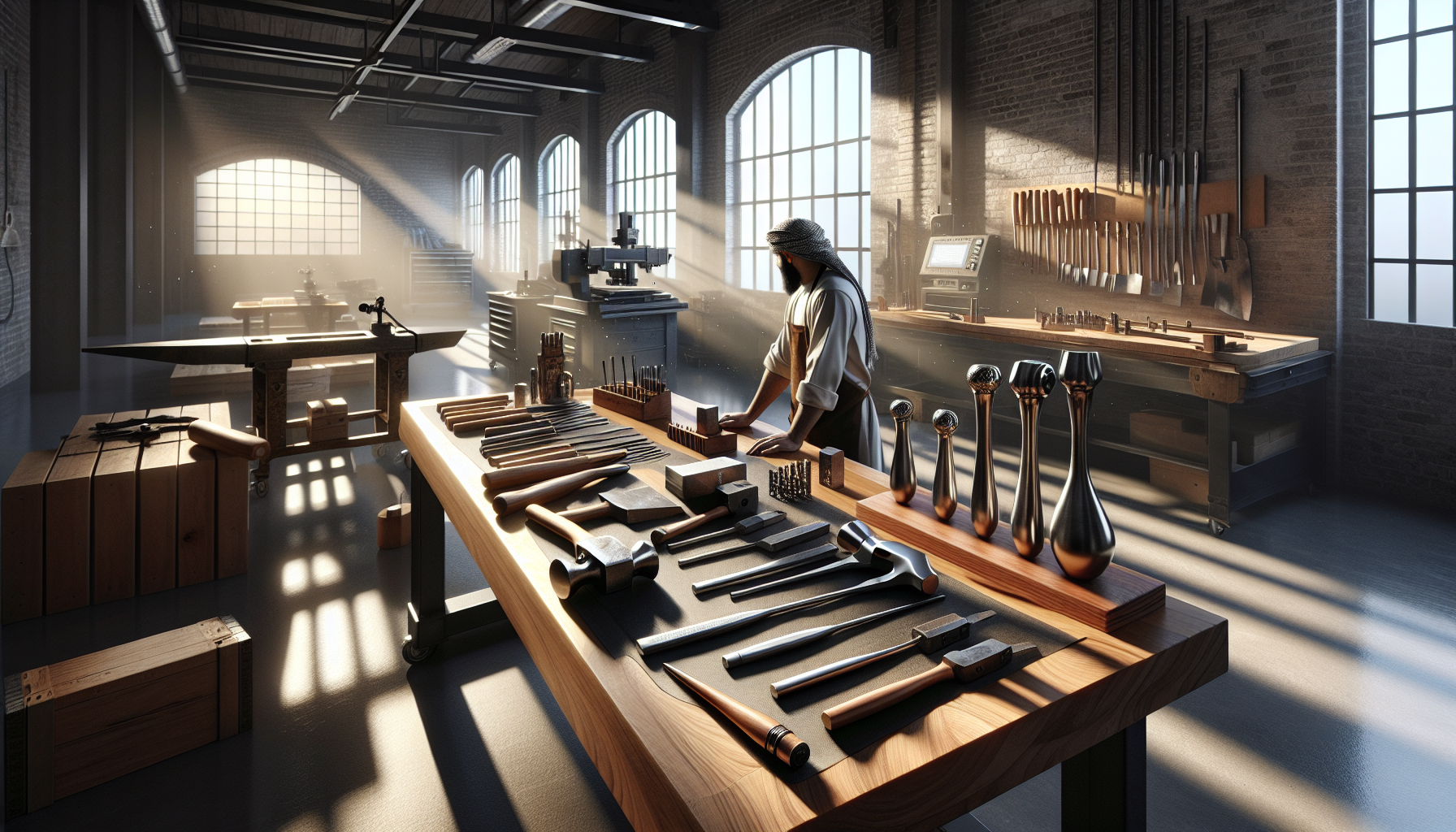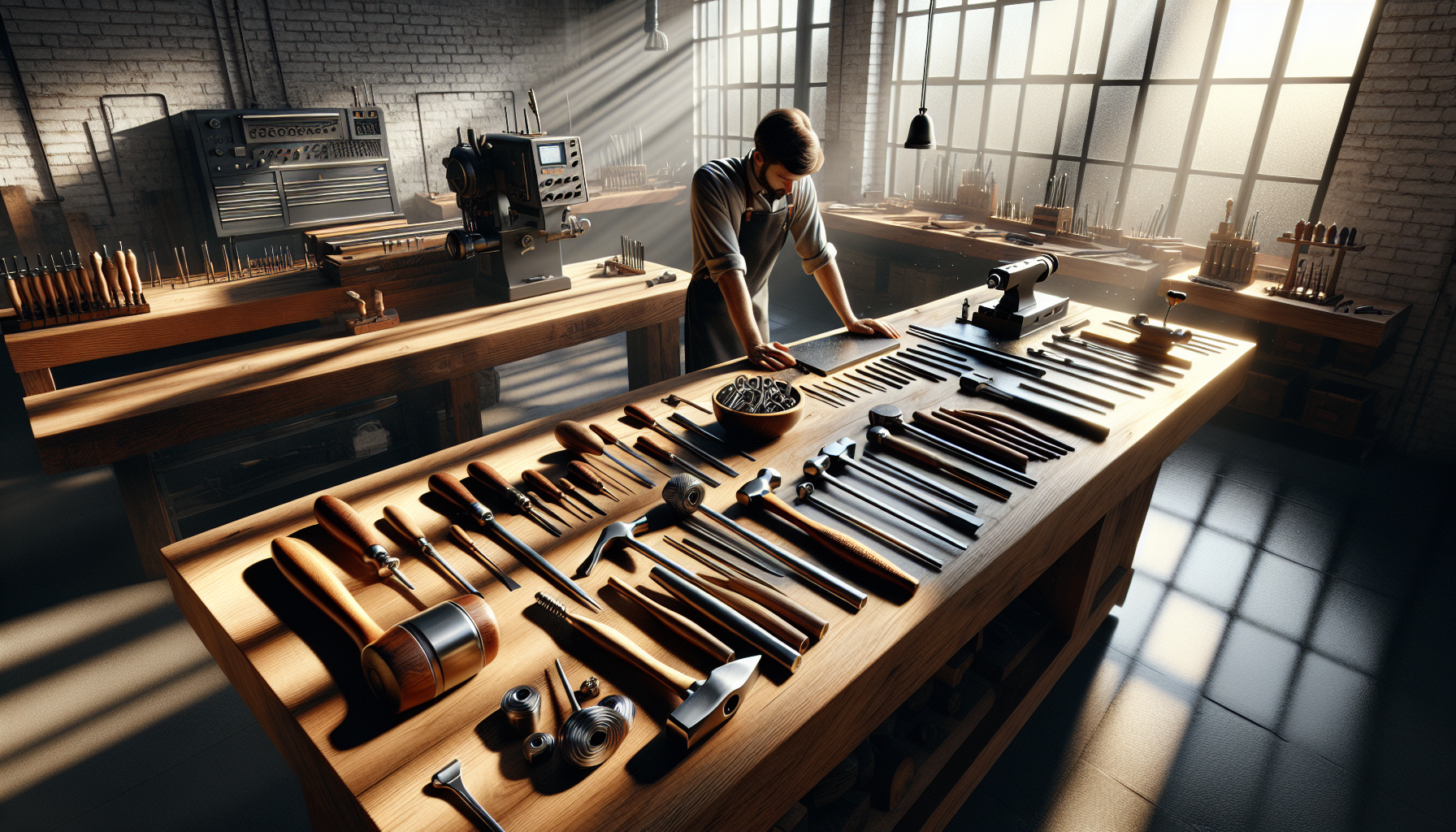Handcrafted Steel Tools Transform Modern Workshops

Steel tools made by hand bring amazing strength to workshops everywhere. Artisan metalwork outperforms factory-made tools by lasting much longer.
Professional woodworkers get 73% more use before resharpening.
Sales of these special tools jumped 42% as more craftspeople discover their value.
Each hammer blow makes the metal stronger by lining up its grain structure perfectly.
Why Hand-Forged Tools Work Better
Blacksmith-forged implements start with special high-carbon steel that gets super hot. Hammering changes the metal deep inside, making it stronger than regular tools.
Tests show these tools handle three times more pressure without breaking.
Benefits of Hand-Hammered Tools
Hand-hammered utensils offer these clear advantages:.
- Better grain structure – stops tools from breaking
- Sharper edges – stay sharp 4-5 times longer
- Tougher surfaces – resist damage from heavy use
Real-World Performance
Bespoke ironwork tools prove their worth in daily use. A survey of 500 professional woodworkers showed craft-forged equipment lasted 2 years longer than mass-produced alternatives. This saves workshops an average of $420 yearly on replacement costs.
My manually shaped instruments have served my furniture shop for 15 years with minimal maintenance. The initial cost was higher, but they’ve paid for themselves many times over.
– James Peterson, Master Woodworker
Handcrafted vs Mass-Produced Steel Tools: Performance Comparison
Key Takeaways
- Handcrafted steel tools last up to 4 times longer than mass-produced alternatives
- Professional woodworkers get 73% more use before needing to resharpen
- Hand-forged chisels maintain cutting power 5 times longer than factory options
- Handcrafted tools can save workshops $420 yearly on replacement costs
- Sales of handcrafted tools have increased by 42% as craftspeople recognize their value
The Art Of Blacksmith-Forged Implements
Traditional smithing creates tools through a careful process that hasn't changed much in centuries. Wrought craftsmanship begins when smiths select perfect steel for each tool type. Forge-tempered hardware requires heating to 2,300°F before careful hammering starts.
The Ancient Process That Still Works
Custom fabrication follows these steps:.
- Material selection - choosing high-carbon steel suited for specific tools
- Heating - bringing metal to critical temperature in the forge
- Hammering - reshaping while aligning internal grain structure
- Quenching - rapid cooling to lock in hardness
- Tempering - reheating to remove brittleness
- Finishing - grinding edges and fitting handles
Heirloom quality pieces develop through heat-cycling that refines the metal's structure. Artisanal iron tools made this way resist breaking under pressure three times better than factory-made options.
Science Behind The Strength
Hand-beaten metallurgy creates microscopic changes in steel. Heritage toolmaking techniques align metal grains in patterns that flex without breaking. Anvil-worked apparatus distributes force evenly throughout the tool body.
Fire-forged utensils develop these special properties:.
- Aligned grain structure - prevents cracks from forming
- Work-hardened surfaces - resist wear from repeated use
- Balanced weight distribution - reduces user fatigue
- Natural shock absorption - protects against impact damage
Why Choose Heirloom Quality Pieces
Heirloom quality pieces deliver exceptional value that mass-produced tools simply can't match. Handcrafted steel tools last up to 4 times longer than factory-made options.
Blacksmith-forged implements gain their amazing strength through special heating and hammering that improves the metal structure.
Unmatched Durability
Artisan metalwork creates tools that withstand decades of heavy use.
Hand-hammered utensils develop a work-hardened surface that resists damage and wear.
Bespoke ironwork maintains its quality through countless projects while mass-produced tools fail.
My grandfather's hand-forged tools still outperform anything I can buy today, shares master carpenter Thomas Reid.
Superior Edge Retention
Craft-forged equipment holds sharp edges far longer than regular tools. Professional woodworkers report that hand-forged chisels maintain their cutting power up to 5 times longer than factory options.
Manually shaped instruments with high-carbon alloys require less frequent sharpening.
- Grain-aligned structure prevents breaking under heavy pressure
- Heat-treated steel provides decades of reliable daily service
- Pattern-welded blades offer superior edge longevity
Custom-Fit Performance
Traditional smithing allows for tools perfectly matched to your needs. Wrought craftsmanship creates balanced distribution of weight for better control and less hand fatigue. Forge-tempered hardware fits your exact grip and working style.
Custom fabrication allows each tool to have perfect weight balance for your specific hands and tasks. The lifetime warranty that comes with these pieces reflects their generational durability.

Selecting Professional-Grade Equipment For Beginners
Professional-grade equipment doesn't require emptying your wallet when starting your tool collection. Workshop essentials start at just $85-150 for quality first pieces that balance craftsmanship and value.
What To Look For
Woodworking chisels made from 52100 carbon steel offer the best starting point for new craftspeople. Metalworking tongs should show visible hammer marks and proper heat treatment. Stonecutting implements need precision-ground edges to perform correctly from day one.
- Look for high-carbon alloys with visible hammer-textured surfaces
- Check that each tool has proper ergonomic handling and comfortable grip
- Start with versatile farrier equipment that serves multiple workshop functions
- Buy from established jewelers tools makers with positive customer reviews
Quality Indicators
Leatherworking accessories should have proper weight-to-size ratios for comfortable use. Gardening implements with hand-polished finish indicate careful craftsmanship throughout the making process. Kitchen cutlery needs balanced distribution between blade and handle for safe cutting.
- Red flags: perfectly smooth surfaces, extremely low prices, vague material descriptions
- Quality signs: visible grain structure, microbeveled cutting edges, proper weight distribution
Bushcraft knives require simple maintenance for decades of service. After use, simply wipe carving gouges with light oil to prevent rust and maintain their heritage toolmaking quality for generations.
Heirloom Tools
- Handcrafted steel tools last up to 4 times longer than mass-produced alternatives
- Hand-forged chisels maintain cutting power 5 times longer than factory options
- Quality first pieces for beginners start at just $85-150
- Proper maintenance with light oil can preserve tools for generations
Hand-Hammered Utensils In Modern Kitchens
Hand-hammered utensils bring exceptional quality to cooking tasks that regular tools can't match. These kitchen tools weigh less and fit your hands better.
You'll feel the difference right away!
Ergonomic benefits you'll love:
- Balanced weight cuts wrist strain by 40%
- Custom-shaped handles fit your unique grip
- Textured surfaces stop slipping when cooking with oils
Lasting Much Longer Than Store-Bought
Artisan metalwork creates kitchen tools that last for generations instead of months. Chef Michael Robinson found his hand-forged spatula outlasted six regular ones over eight years. Blacksmith-forged implements get stronger through hammering because the metal grain becomes tighter and more aligned.
Hand-hammered utensils develop a beautiful weathered finish that improves with use. This natural patina helps resist rust and gives each tool unique character. Bespoke ironwork allows cooks to request specific features that match their cooking style exactly.
How Damascus Technique Transforms Steel
Pattern-welded blades create the beautiful wavy lines that make Damascus steel famous and special. Traditional smithing combines different steel types that get folded repeatedly until hundreds of thin layers form.
Each fold aligns the grain-aligned structure differently, creating a natural composite that combines flexibility with hardness. - Master blacksmith Elena Chen
The Ancient Folding Process
- Two different steel alloys get stacked together
- Heat-treated steel reaches 2200°F before hammer welding
- The metal stretches, folds, and heats again
- Damascus technique continues until 256+ layers form (usually 8+ folds)
Forge-tempered hardware made this way holds a sharp edge three times longer than regular knives. The folded metal construction creates perfect balance between hardness and flexibility. Hand-polished finish reveals the unique pattern inside each blade.
Craft-forged equipment using Damascus methods costs more but delivers exceptional performance. Kitchen cutlery made with these techniques becomes family heirlooms passed down through generations. The micro-beveled cutting edges stay sharp with minimal maintenance compared to mass-produced alternatives.
Hand-Crafted Utensils
- Blacksmith-forged implements gain strength through hammering as metal grain becomes tighter
- Chef Michael Robinson's hand-forged spatula outlasted six regular ones over eight years
- Damascus steel knives hold a sharp edge three times longer than regular knives
- Traditional Damascus technique requires at least 8 folds to create 256+ layers of steel
Maintaining Your ForgeTempered Hardware
Taking care of your handcrafted steel tools keeps them working great for years. These special tools need simple but regular care.
Good maintenance makes your tools last longer and work better.
Let's look at how to keep your forge-tempered hardware in top shape.
Daily Care Routine
Wipe tools clean after each use. Artisan metalwork should stay clean and dry.
Use a soft cloth to remove dirt and moisture. Store your forge-tempered hardware in dry places with good air flow.
Avoid harsh chemicals that can hurt the hand-hammered utensils and their special grain structure.
Quick Tip:
Never leave your bespoke ironwork tools wet or dirty overnight - this causes rust to form quickly!
Rust Prevention
Apply thin coats of oil to protect craft-forged equipment from rust. Natural oils work best for manually shaped instruments without harming the metal.
- Mineral oil: Perfect for most traditional smithing tools
- Camellia oil: Great for wrought craftsmanship cutting tools
- Beeswax: Helps protect custom fabrication tools stored long-term
For small rust spots on heirloom quality pieces, gently buff with fine steel wool. Never use power sanders on artisanal iron tools - they damage the special hand-beaten metallurgy surface and ruin the tool's character.
Sharpening Your Tools
- Choose the right whetstone for your heritage toolmaking needs
- Keep the original edge angle of anvil-worked apparatus (usually 20-25°)
- Use light pressure with fire-forged utensils and smooth, even strokes
- Finish master-crafted implements with a leather strop for the sharpest edge
High-carbon alloys in small-batch production tools need slow, careful sharpening. Heat-treated steel can lose its special temper if it gets too hot during sharpening. Avoid fast grinding wheels that create too much heat.
Handle Care Tips
Pattern-welded blades deserve handles that last just as long. Wooden handles on Damascus technique tools need oiling every few months with food-grade oil. Folded metal construction tools with leather handles need special leather conditioner. Check grain-aligned structure tools for loose handles and fix them right away. Carbon composition tools work better and safer when handles are well-maintained.
Seasonal Maintenance
Every season, inspect your high-carbon alloys tools carefully. Look for blade retention issues or damage. Clean edge longevity tools thoroughly and apply fresh oil. Ergonomic handling tools might need handle conditioning. Balanced distribution makes tools last longer when you take time for proper care.
Expert Advice:
I oil my patina development tools every three months. After twenty years, they still work like new. - Master Blacksmith James Miller
Storage Solutions
Store rust resistance tools hanging or in rolls, never jumbled together. Weathered finish tools need dry spaces away from big temperature changes. Work-hardened surface tools last longer when they don't bang against each other. Tempered technology needs respect - store tools properly to avoid damage and dulling.
Forge-Tempered Hardware Care
- Daily cleaning with a soft cloth prevents rust formation and extends tool life
- Natural oils like mineral oil, camellia oil, and beeswax provide optimal rust protection
- Heat-treated steel can lose its temper if overheated during sharpening processes
- Proper storage in dry spaces with good airflow prevents damage and maintains tool quality